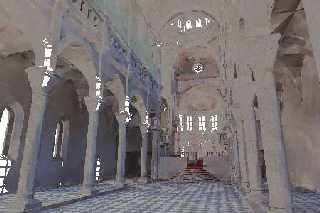 |
 |
|
 |
|
 |
|  |
|  |
|
 |
|
 |
|  |
|  |
|
 |
I was testing a ligting setup and it came out pretty good.
The model and image maps from hdri.cgtechniques.com/~sibenik2/
1 light source and ambient sky dome. save_data with error_bound 0.05
and final with error_bound 0.2.
Findings.
Clipped radiosity samples are only an annoyance. The 2nd image
demonstrates this effect when the scene is rendered directly to
display. I used sorcery to get nonclipped radiosity from std 3.5.
1600 samples isn't enough to gather smooth illumination from sources
with small solid angle.
Radiosity ignores brilliance finish parameter. Not that important
but would add that extra touch of realism.
_____________
Kari Kivisalo
Post a reply to this message
Attachments:
Download 'test_load_normal2.jpg' (177 KB)
Download '1_1.jpg' (18 KB)
Preview of image 'test_load_normal2.jpg'

Preview of image '1_1.jpg'

|
 |
|  |
|  |
|
 |
|
 |
|  |
|  |
|
 |
Wow that looks totally awesome!
Somehow it doesn't look real, but looks like a really amazing painting, or
something. In any case I like it!
I particularly like the way the light seems to bleed where it hits objects
directly, is that just radiosity or some sort of post processing effect?
--
Tek
http://www.evilsuperbrain.com
Post a reply to this message
|
 |
|  |
|  |
|
 |
|
 |
|  |
|  |
|
 |
Wow. The whole contrast and beauty of this image is amazing! Sometimes it's
better if it's not quite photorealistic but rather a kind of
"superrealistic" that you could only see in your dreams or art.
BTW, is your "sorcery" a secret? Or did you scale down the brightness to
within the 0 1 range and postprocess? I wouldn't call it cheating if it was
only used to avoid a titanic oversight in the radiosity engine. :-T
--
light_source#macro G(E)sphere{z+E*y*5e-3.04rotate-z*E*6pigment{rgbt#end{
20*y-10#local n=162;1}#while(n)#local n=n-.3;G(n)x}}G(-n).7}}#end//GregE
Post a reply to this message
|
 |
|  |
|  |
|
 |
|
 |
|  |
|  |
|
 |
>BTW, is your "sorcery" a secret? Or did you scale down the brightness to
>within the 0 1 range and postprocess?
You can avoid the postprocess. Just wrap a tiny sphere around the camera
with the following attributes:
pigment {rgbf <BRIGHTNESS,BRIGHTNESS,BRIGHTNESS,1>}
finish {ambient 0 diffuse 0}
no_shadow no_reflection hollow
....and the brightness of each pixel will be multiplied by BRIGHTNESS. So
set BRIGHTNESS to 20 or so, divide all your lights' colors by BRIGHTNESS,
and you get a nice image. Radiosity seems to get slower as BRIGHTNESS
increases, though.
Post a reply to this message
|
 |
|  |
|  |
|
 |
|
 |
|  |
|  |
|
 |
> 1600 samples isn't enough to gather smooth illumination from sources
> with small solid angle.
if you're patient enough to do some tests with values > 1600 you can try my
halton patch (http://195.221.122.126/tmp/mlpov83-win-bin.zip or the full
package http://195.221.122.126/mlpov83.zip) , just add
#version unofficial mlpov 0.82;
and by adding the keyword "halton" in the radiosity options you can use
count > 1600
M
Post a reply to this message
|
 |
|  |
|  |
|
 |
|
 |
|  |
|  |
|
 |
Kari Kivisalo wrote:
>
> I was testing a ligting setup and it came out pretty good.
>
> The model and image maps from hdri.cgtechniques.com/~sibenik2/
> 1 light source and ambient sky dome. save_data with error_bound 0.05
> and final with error_bound 0.2.
Very nice.
Must take quite long to render...
> Findings.
>
> Clipped radiosity samples are only an annoyance. The 2nd image
> demonstrates this effect when the scene is rendered directly to
> display. I used sorcery to get nonclipped radiosity from std 3.5.
>
> 1600 samples isn't enough to gather smooth illumination from sources
> with small solid angle.
Both problems will be fixed in next MegaPOV. I guess the 'sorcery' means
rendering on a lower lighting level and adjusting afterwards.
Christoph
--
POV-Ray tutorials, include files, Sim-POV,
HCR-Edit and more: http://www.tu-bs.de/~y0013390/
Last updated 28 Feb. 2003 _____./\/^>_*_<^\/\.______
Post a reply to this message
|
 |
|  |
|  |
|
 |
|
 |
|  |
|  |
|
 |
Nice to see another POV trace of that building. What strikes me is the huge
difference in render-time between different raytracing engines. Most of them
are able to make it look great - but not similar to each other - the
differene is however, the render time... and POV doesn't seem to perform too
fast.
Regards,
Hugo
Post a reply to this message
|
 |
|  |
|  |
|
 |
|
 |
|  |
|  |
|
 |
Tek wrote:
>
> Somehow it doesn't look real, but looks like a really amazing
> painting, or something.
The scene would not look like this when viewed directly or in a
normal photograph. The goal was to make a record of the HDR light
levels for reference purposes. Maybe this is why the dreamy/painterly
look.
The glow effect for the hot spots seemed appropriate as their
brightness is about 10000%. Some of it is bound to spill over :)
Generating the radiosity data took 12 hours on XP 2100.
_____________
Kari Kivisalo
Post a reply to this message
|
 |
|  |
|  |
|
 |
|
 |
|  |
|  |
|
 |
I have a set of 32000 samples here: http://24.132.254.156/raddist7_32000.zip
. The file contains c-code and .inc POV-Ray code. The XYZ-samples are
normalized non-integer values so the "resolution" of the values is higher
than the shorts of the official version. I'm just to lazy and weary of
compiling POV-Ray now, because there is a 50% chance or something like that
for crashing my system when I try compiling.
Post a reply to this message
|
 |
|  |
|  |
|
 |
|
 |
|  |




![]()